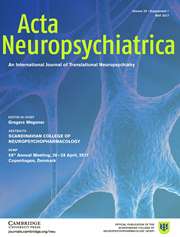No CrossRef data available.
Article contents
Association of Glucagon-Like Peptide-1 Receptor Agonists (GLP-1 RAs) and Neurogenesis: A Systematic Review
Published online by Cambridge University Press: 14 February 2025
Abstract
Glucagon-like peptide-1 (GLP-1) and glucagon-like peptide-1 receptor agonist (GLP-1 RA) administration has been associated with neuroproliferative effects and modulatory effects in neuronal pathways. Herein, we conducted a comprehensive synthesis of the effects of GLP-1 and GLP-1 RAs on neurogenesis.
We examined studies that investigate changes in neurogenesis mediated by GLP-1 and GLP-1 RA administration in both human and animal populations. Relevant articles were retrieved through OVID (MedLine, Embase, AMED, PsychINFO, JBI EBP Database), PubMed, and Web of Science from database inception to July 2nd. Primary studies investigating the role of GLP-1 and GLP-1 RAs on neurogenesis were included for analysis.
GLP-1 and GLP-1 RAs (i.e. exenatide, geniposide, liraglutide, lixisenatide, and semaglutide), increased neurogenesis within the dentate gyrus, hippocampus, olfactory bulb, and the medial striatum in animal models. Additionally, GLP-1 and GLP-1 RAs were associated with modulating changes in multiple apoptotic pathways and upregulating survival pathways.
GLP-1 and GLP-1 RAs are positively associated with neurogenesis. This effect may have translational implications insofar as disparate mental disorders that are characterized by neurogenesis defects (e.g. depressive disorders and neurocognitive disorders) may be benefitted by these agents.
Keywords
- Type
- Review Article
- Information
- Copyright
- © The Author(s), 2025. Published by Cambridge University Press on behalf of Scandinavian College of Neuropsychopharmacology


